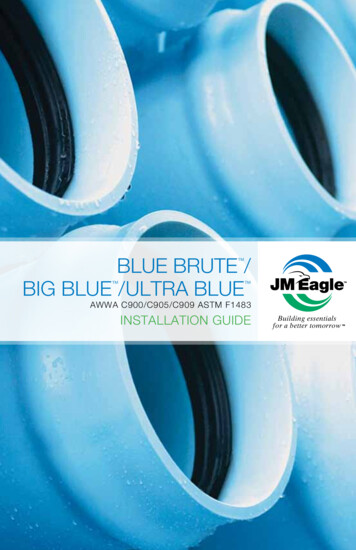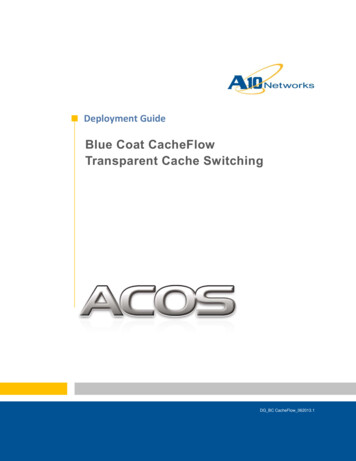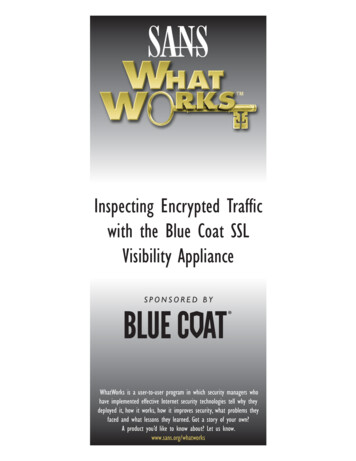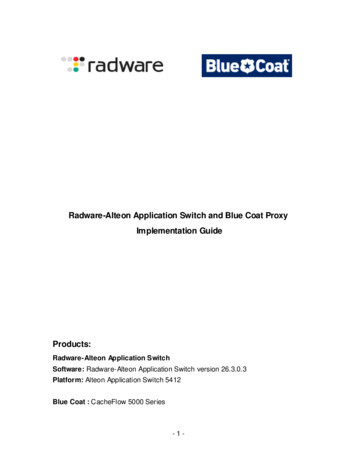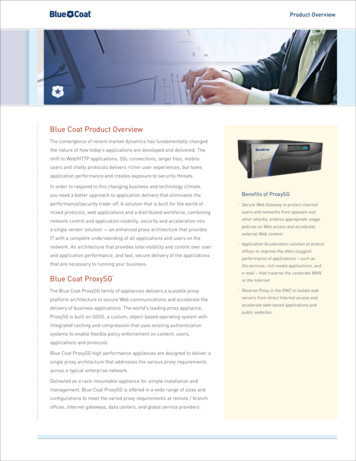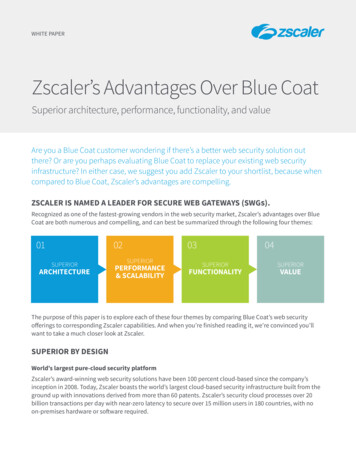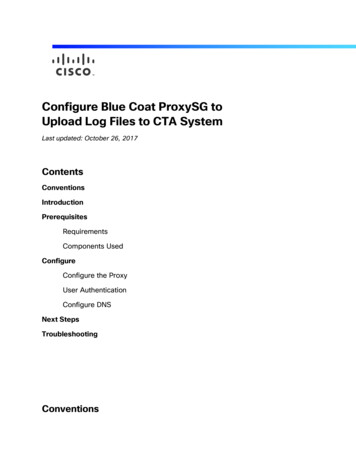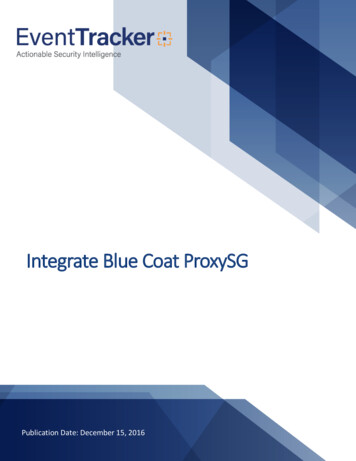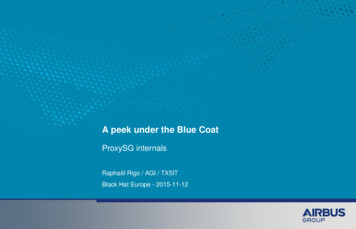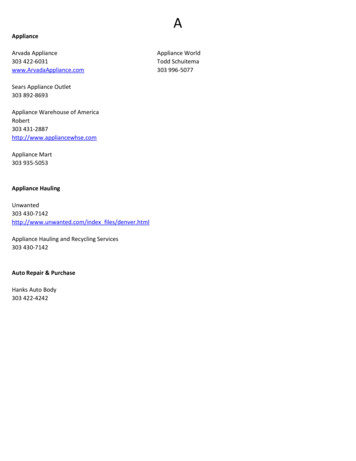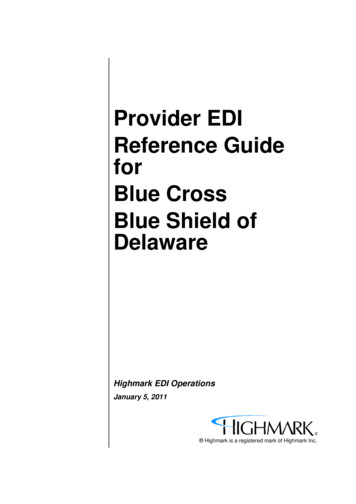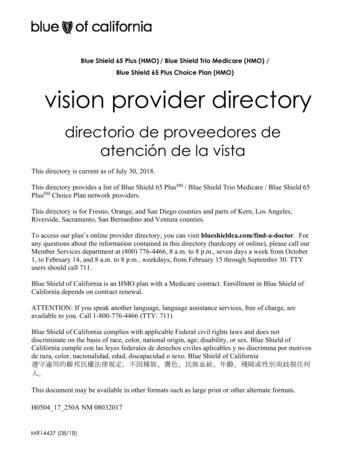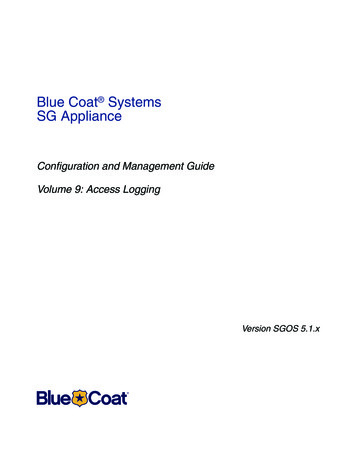
Transcription
Blue Coat SystemsSG ApplianceConfiguration and Management GuideVolume 9: Access LoggingVersion SGOS 5.1.x
Volume 9: Access LoggingContact InformationBlue Coat Systems Inc.420 North Mary AveSunnyvale, CA r concerns or feedback about the documentation: documentation@bluecoat.comCopyright 1999-2007 Blue Coat Systems, Inc. All rights reserved worldwide. No part of this document may be reproduced by any meansnor modified, decompiled, disassembled, published or distributed, in whole or in part, or translated to any electronic medium or othermeans without the written consent of Blue Coat Systems, Inc. All right, title and interest in and to the Software and documentation areand shall remain the exclusive property of Blue Coat Systems, Inc. and its licensors. ProxyAV , CacheOS , SGOS , SG , SpywareInterceptor , Scope , RA Connector , RA Manager , Remote Access are trademarks of Blue Coat Systems, Inc. and CacheFlow ,Blue Coat , Accelerating The Internet , ProxySG , WinProxy , AccessNow , Ositis , Powering Internet Management , The UltimateInternet Sharing Solution , Permeo , Permeo Technologies, Inc. , and the Permeo logo are registered trademarks of Blue Coat Systems,Inc. All other trademarks contained in this document and in the Software are the property of their respective owners.BLUE COAT SYSTEMS, INC. DISCLAIMS ALL WARRANTIES, CONDITIONS OR OTHER TERMS, EXPRESS OR IMPLIED,STATUTORY OR OTHERWISE, ON SOFTWARE AND DOCUMENTATION FURNISHED HEREUNDER INCLUDING WITHOUTLIMITATION THE WARRANTIES OF DESIGN, MERCHANTABILITY OR FITNESS FOR A PARTICULAR PURPOSE ANDNONINFRINGEMENT. IN NO EVENT SHALL BLUE COAT SYSTEMS, INC., ITS SUPPLIERS OR ITS LICENSORS BE LIABLE FORANY DAMAGES, WHETHER ARISING IN TORT, CONTRACT OR ANY OTHER LEGAL THEORY EVEN IF BLUE COAT SYSTEMS,INC. HAS BEEN ADVISED OF THE POSSIBILITY OF SUCH DAMAGES.Document Number: 231-02845Document Revision: SGOS 5.1.x 03/2007ii
ContentsContact InformationChapter 1: About Access LoggingOverview .5Understanding Facilities .5Understanding Protocols and Formats .6Enabling or Disabling Access Logging .7Document Conventions.8Chapter 2: Creating and Editing Log FormatsCreating a Custom or ELFF Log Format.11Chapter 3: Creating and Editing Access Log FacilityEditing an Existing Log Facility .16Associating a Log Facility with a Protocol .17Disabling Access Logging for a Particular Protocol.18Configuring Global Settings .18Chapter 4: Configuring the Upload ClientEncrypting the Access Log.22Importing an External Certificate .22Deleting an External Certificate .23Digitally Signing Access Logs .23Disabling Log Uploads .26Decrypting an Encrypted Access Log .26Verifying a Digital Signature .26Editing Upload Clients .26Editing the FTP Client .27Editing the HTTP Client.28Editing the Custom Client .29Editing the Custom SurfControl Client .30Editing the Websense Client.31Chapter 5: Configuring the Upload ScheduleTesting Access Log Uploading .35Viewing Access-Log Statistics .35Viewing the Access Log Tail.36Viewing the Log File Size.36Viewing Access Logging Status .37Viewing Access-Log Statistics .38Example: Using VPM to Prevent Logging of Entries Matching a Source IP .40iii
Volume 9: Access LoggingAppendix A: GlossaryAppendix B: Access Log FormatsCustom or W3C ELFF Format. 51Example Access Log Formats. 53SQUID-Compatible Format . 53Action Field Values. 54NCSA Common Access Log Format . 55Access Log Filename Formats. 56Fields Available for Creating Access Log Formats . 57Indexiv
Chapter 1: About Access LoggingAccess logging allows you to track Web usage for the entire network or specificinformation on user or department usage patterns. These logs and reports can be madeavailable in real-time or on a scheduled basis.Note: Event logging is not the same as access logging. Event logging allows you tospecify the types of system events logged, the size of the event log, and to configureSyslog monitoring.OverviewSGOS can create access logs for the traffic flowing through the system; in fact, eachprotocol can create an access log record at the end of each transaction for that protocol(such as for each HTTP request).Note: The only data that can be logged in an access log on the SG appliance are theaccess-log fields and the CPL fields (found in Appendix B: "Access Log Formats").These log records can be directed to one or more log facilities, which associates the logswith their configured log formats, upload schedules, and other customizablecomponents. In addition, access logs can be encrypted and digitally signed prior toupload.Data stored in log facilities can be automatically uploaded to a remote location foranalysis and archive purposes. The uploads can take placing using HTTP, FTP, or oneof several proprietary protocols. Once uploaded, reporting tools such as Blue CoatReporter can be used to analyze the log files. For information on using Blue CoatReporter, refer to the Blue Coat Reporter Configuration and Management Guide.Understanding FacilitiesA log facility is a separate log that contains a single logical file and supports a single logformat. The facility contains the file’s configuration and upload schedule informationas well as other configurable information such as how often to rotate (switch to a newlog) the logs at the destination, any passwords needed, and the point at which thefacility can be uploaded.Multiple access log facilities are supported, although each access log supports a singlelog format. You can log a single transaction to multiple log facilities through a globalconfiguration setting for the protocol that can be modified on a per-transaction basisvia policy.5
Volume 9: Access LoggingUnderstanding Protocols and FormatsThe following protocols support configurable access logging: CIFS Endpoint Mapper FTP HTTP HTTPS Forward Proxy HTTPS Reverse Proxy ICP Instant Messaging Peer-to-peer (P2P) RealMedia/QuickTime SOCKS SSL TCP Tunnel Telnet Windows Media6
Chapter 1: About Access LoggingSGOS can create access logs with any one of a number of log formats, and you can createadditional types using custom or ELFF format strings. The log types supported are: NCSA common log format SQUID-compatible format ELFF (W3C Extended Log File Format) Custom, using the strings you enter SmartReporter, an ELFF log format compatible with the SmartFilter Reporter tool SurfControl, a log format compatible with the SurfControl Reporter tool Websense, a log format compatible with the Websense Reporter toolThe log facilities, each containing a single logical file and supporting a single log format,are managed by policy (created through VPM or CPL), which specifies the destination logformat and log file.Enabling or Disabling Access LoggingYou can globally enable or disable access logging. If access logging is disabled, logging isturned off for all log objects, even if logging policy exists or logging configurations are set.Once globally enabled, connection information is sent to the default log facility for theservice. For example, HTTP traffic is logged to the main file.By default, access logging is disabled on all new systems, but certain protocols areconfigured to use specific logs by default. When access logging is enabled, logging beginsimmediately for all configured protocols.To enable or disable access logging:1.Select Configuration Access Logging General Default Logging.22.Select Enable to enable access logging or deselect it to disable access logging.3.Select Apply to commit the changes to the SG appliance.Volume 9: Access Logging contains the following topics: Chapter 2: "Creating and Editing Log Formats" on page 97
Volume 9: Access Logging Chapter 3: "Creating and Editing Access Log Facility" on page 15 Chapter 4: "Configuring the Upload Client" on page 21 Chapter 5: "Configuring the Upload Schedule" on page 33 Appendix A: "Glossary" on page 43 Appendix B: "Access Log Formats" on page 51Document ConventionsThe following section lists the typographical and Command Line Interface (CLI) syntaxconventions used in this manual.Table 1-1. Document ConventionsConventionsDefinitionItalicsThe first use of a new or Blue Coat-proprietary term.Courier fontCommand line text that appears on your administrator workstation.Courier ItalicsA command line variable that is to be substituted with a literal name orvalue pertaining to the appropriate facet of your network system.Courier BoldfaceA Blue Coat literal to be entered as shown.{}One of the parameters enclosed within the braces must be supplied[]An optional parameter or parameters. Either the parameter before or after the pipe character can or must beselected, but not both.8
Chapter 2: Creating and Editing Log FormatsYou should first decide what protocols and log formats you want to use, the loggingpolicy, and the upload schedule. Then you can do the following: Associate a log format with the log facility. Associate a log facility with a protocol and/or create policies for protocolassociation and to manage the access logs and generate entries in them (if you doboth, policy takes precedence). Determine the upload parameters for the log facility.The Format tab allows you to create a format to use for your log facilities. Several logformats ship with the SGOS software, and they might be sufficient for your needs. If theformats that exist do not meet your needs, you can use the Format tab to create acustom or ELFF format and specify the string and other qualifiers used.Several log formats already exist. For a description of each value in the log, seeAppendix B: "Access Log Formats" on page 51. cifs: This is an ELFF format with the custom strings ofdate time c-ip r-ip r-port x-cifs-method x-cifs-server x-cifs-sharex-cifs-path x-cifs-orig-path x-cifs-client-bytes-read x-cifs-serverbytes-read x-cifs-bytes-written s-action cs-username cs-auth-groups-ip mapi: This is an ELFF format with the custom strings ofdate time c-ip c-port r-ip r-port x-mapi-user x-mapi-method cs-bytessr-bytes rs-bytes sc-bytes x-mapi-cs-rpc-count x-mapi-sr-rpc-countx-mapi-rs-rpc-count x-mapi-sc-rpc-count s-action cs-username csauth-group s-ip im (Instant Messaging): This is an ELFF format with the custom strings of:date time c-ip cs-username cs-auth-group cs-protocol x-im-method xim-user-id x-im-user-name x-im-user-state x-im-client-info x-imbuddy-id x-im-buddy-name x-im-buddy-state x-im-chat-room-id x-imchat-room-type x-im-chat-room-members x-im-message-text x-immessage-size x-im-message-route x-im-message-type x-im-file-path xim-file-size s-action main: This is an ELFF format with custom strings of:date time time-taken c-ip sc-status s-action sc-bytes cs-bytes csmethod cs-uri-scheme cs-host cs-uri-port cs-uri-path cs-uri-querycs-username cs-auth-group s-hierarchy s-supplier-name rs(ContentType) cs(User-Agent) sc-filter-result cs-category x-virus-id s-ip ssitename ncsa: This is a reserved format that cannot be edited. The NCSA/Common formatcontains the following strings:remotehost rfc931 authuser [date] “request” status bytesThe ELFF/custom access log format strings that represent the strings above are: (c-ip) - (cs-username) (localtime) (cs-request-line) (scstatus) (sc-bytes)9
Volume 9: Access Logging p2p: This is an ELFF format with custom strings of:date time c-ip c-dns cs-username cs-auth-group cs-protocol x-p2pclient-type x-p2p-client-info x-p2p-client-bytes x-p2p-peer-bytesduration s-action smartreporter: This is a reserved format that cannot be edited. It contains thefollowing string:localtime s-computername c-ip c-uri sc-filter-result cs-categories csuser sc-bytes squid: This is a reserved format that cannot be edited. You can create a new SQUID logformat using custom strings. The default SQUID format is SQUID-1.1 and SQUID-2compatible.SQUID uses several definitions for its field formats:SQUID-1:time elapsed remotehost code/status/peerstatus bytes methodURLSQUID-1.1: time elapsed remotehost code/status bytes method URL rfc931peerstatus/peerhost typeSQUID-2 has the same fields as SQUID-1.1, although some of the field values havechanged. ssl: This is an ELFF format with custom strings of:date time time-taken c-ip s-action x-rs-certificate-validate-status xrs-certificate-observed-errors cs-host s-hierarchy s-supplier-name xrs-connection-negotiated-ssl-version egotiated-cipher-size x-rs-certificate-hostname x-rscertificate-hostname-category ion-negotiated-cipher x-cs-connection-negotiated-ciphersize x-cs-certificate-subject s-ip s-sitename streaming: This is an ELFF format with custom strings of:c-ip date time c-dns cs-uri-scheme cs-host cs-uri-port cs-uri-path csuri-query c-starttime x-duration c-rate c-status c-playerid cplayerversion c-playerlanguage cs(User-Agent) cs(Referer) c-hostexe chostexever c-os c-osversion c-cpu filelength filesize avgbandwidthprotocol transport audiocodec videocodec channelURL sc-bytes c-bytess-pkts-sent c-pkts-received c-pkts-lost-client c-pkts-lost-net c-pktslost-cont-net c-resendreqs c-pkts-recovered-ECC c-pkts-recoveredresent c-buffercount c-totalbuffertime c-quality s-ip s-dns stotalclients s-cpu-util x-cache-user x-cache-info x-client-address surfcontrol, surfcontrolv5, and smartfilter: These are reserved formats that cannot beedited. websense: This is a reserved format that cannot be edited. bcreportermain v1: This is a reserved format that cannot be edited:date time time-taken c-ip cs-username cs-auth-group x-exception-id scfilter-result cs-categories cs(Referer) sc-status s-action cs-methodrs(Content-Type) cs-uri-scheme cs-host cs-uri-port cs-uri-path cs-uriquery cs-uri-extension cs(User-Agent) s-ip sc-bytes cs-bytes x-virusid10
Chapter 2: Creating and Editing Log Formats bcreporterssl v1: This is a reserved format that cannot be edited. It only containsfields that do not reveal private or sensitive information, unlike the bcreportermain v1format:date time time-taken c-ip cs-username cs-auth-group x-exception-id scfilter-result cs-categories sc-status s-action cs-method rs(ContentType) cs-uri-scheme cs-host cs-uri-port cs-uri-extension cs(UserAgent) s-ip sc-bytes cs-bytes x-virus-id x-rs-certificate-observederrors x-rs-connection-negotiated-cipher-strength x-rs-certificatehostname x-rs-certificate-hostname-category bcreportercifs v1: This is a reserved format that cannot be edited:date time c-ip c-port r-ip r-port x-cifs-uid x-cifs-tid x-cifs-fid xcifs-method x-cifs-server x-cifs-share x-cifs-path x-cifs-orig-path xcifs-client-bytes-read x-cifs-server-bytes-read x-cifs-bytes-writtenx-client-connection-bytes x-server-connection-bytes x-server-adnconnection-bytes x-cifs-client-read-operations x-cifs-client-writeoperations x-cifs-client-other-operations x-cifs-server-operations saction x-cifs-error-code cs-username cs-auth-group s-ipNote: If you had previously created formats with the name smartreporter or surfcontrolv5and you upgrade the device, those formats are changed to smartreporter user orsurfcontrolv5 user. If you already have a log format named smartreporter user orsurfcontrolv5 user, then the names become smartreporter user1 or surfcontrolv5 user1.This naming protocol continues ( user2, user3.) as necessary. The logs associated withthese formats are automatically associated with the new format name.Creating a Custom or ELFF Log FormatComplete the following steps to create a custom or ELFF log format.To create or edit the log format:1.Select Configuration Access Logging Formats.2.Click New (or highlight a format and click Edit). The Create Format dialog displays. Ifyou select an unconfigurable format, you receive an error mes
SurfControl, a log format compatible with the SurfControl Reporter tool Websense, a log format compatible with the Websense Reporter tool The log facilities, each containing a single logical file and supporting a single log format, are managed by policy (created through VPM or CPL), which specifies
